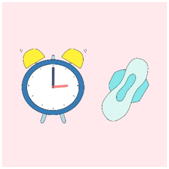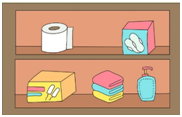
Which are the available menstrual hygiene materials?
There is a range of period protection products available to deal with menstruation. Some of the common products used are- cloths, disposable pads, reusable pads, menstrual cups, tampons etc.

You can choose any product according to your physical and emotional comfort, however maintaining hygiene is what matters the most.
Importance of maintaining menstrual hygiene and cleanliness
Poor menstrual hygiene practices set a perfect environment for the growth of harmful bacteria which could be a risk to your health. These harmful bacteria can invade reproductive system and cause serious diseases. Thus, good hygiene practices during menstruation help girls and women to stay healthy and enjoy stress-free periods, without discomfort or pain associated with infections.Below are some of the important reasons to maintain good hygiene during menstruation:
- Reduce incidence to allergy and rashes in genitals
- Reduce risk of urinary tract infections
- Minimize the risk of Hepatitis B infection and cervical cancer
- Ensure good reproductive health
- Reducing abdominal pain or back pain due to infections
Some important statistics
- About 336 million girls and women in India are of reproductive age and menstruate for 2-7 days, every month.
- Only 58% women of age 15-24 years use any hygienic method of protection.
- Over 140 million girls and women in India are ignorant of safe menstrual hygiene practices.
- Poor menstrual hygiene increases the incidence of reproductive tract infections by 70%.
- Over 90% of the menstrual problems are preventable if treated at an early stage.
How menstrual hygiene can be maintained?
1. Change your absorbent every 4-6 hours
2. Wash your genitals every time you change absorbent or a minimum of 2-3 times a day during periods
 Even after changing or removing the napkin or absorbent, the bacteria may remain on your body. Thus, washing genitals during periods in extremely important to prevent growth of harmful bacteria.
Even after changing or removing the napkin or absorbent, the bacteria may remain on your body. Thus, washing genitals during periods in extremely important to prevent growth of harmful bacteria.Vagina has its own cleaning mechanism. So, it is OKAY if you do not use soap and vagina hygiene products to clean yourself.
3. Washing hands with soap every time you change or dispose the absorbent is another essential hygiene practice to reduce the scope of infections.

Washing hands with soap every time you change or dispose the absorbent is another essential hygiene practice to reduce the scope of infections.
4. Keep the sanitary products in a clean place

Sanitary products should be stored in a clean and dry place to avoid any contamination.
5. If using reusable products, wash and dry the product after every use as instructed

Sanitary napkins or products that are reusable for several menstrual cycles, should be clean properly after every use. The harmful germs may remain on these products if cleanliness is not ensured. It is very important to follow the instructions given for washing, drying and storing reusable products.
6. Wear clean underwear every day or change it when it is soiled from discharge
Wearing same or soiled underwear during your periods can also cause skin irritations, infections and produce bad odour. So, clean and comfortable underwear should be used during menstruation.
7. Don’t be afraid or shy from consulting a doctor for any serious problem

If you experience abnormally long, painful or heavy menstruation, it is better to consult a doctor and seek advice early. It will help prevent the onset of other associated diseases, as well as help in beginning effective treatment processes.
Menstrual Hygiene Management
